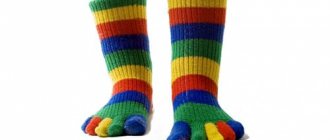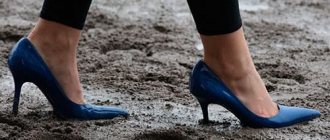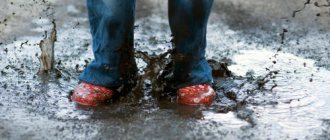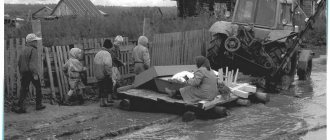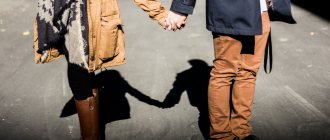Attitudes towards barefoot running are contradictory: some say that it is stupid and dangerous, others say, on the contrary, that we are created precisely for this kind of running.
Since Nike launched the first specialized running shoes, sales of such shoes have grown at a breakneck pace, new brands and technologies have appeared, and at the same time marketers have convinced us of the need for soft soles, foot support, correction of pronation and supination, and others. solutions to runners' problems.
After the release of Christopher McDougle's Born to Run in 2009, the conversation around barefoot running was revived, and brands jumped on the bandwagon with minimalist, thin-soled running shoes.
Marathonica running school coach Ekaterina Preobrazhenskaya will help you understand the nuances of barefoot running.
Why do you need running shoes?
We are born without shoes - this is already proof that our body is ready to do without shoes. If you look at things radically, then the body is already designed in an optimal way to perform the functions necessary for survival and development.
Since running is one of the types of movement inherent in humans, nothing additional is needed for it. But civilization has brought us many benefits that create additional comfort, and running shoes are one of them.
When a small child begins to walk and soon run, as a rule, he constantly wants to take off his shoes. And this is not without reason: for those who are not yet accustomed to boots, walking barefoot is much more pleasant and convenient.
When we don't put our feet in shoes, the muscles of the arch and ankle work and develop with every step, and they are subsequently responsible for shock absorption when running and walking. If this natural process is disrupted, then as a result, the knees, hip joints and spine will begin to suffer along the chain, because it is the arch of the arch of the foot that is created by nature to “practice” the landing.
Read on the topic: What is pronation and supination of the foot when running
marathon and half marathon training plans and start training today!
But it is impossible to avoid shoes unless you live in a village, if only because they protect from dirt, sharp objects and cold. Therefore, we quickly get used to boots, with all the ensuing consequences of muscle underdevelopment.
Let’s add here a predominantly sedentary lifestyle and we get the typical image of a modern person who wants to “clear his head” by jogging at least several times a week.
Of course, few people, before starting to run, do long and hard exercises for the feet in order to develop the corresponding muscles. The result is pain, injury and discomfort from running. This is where sports brands come to the rescue, acting as “saviors”: they promise that their knees and spine are reliably protected in their sneakers with advanced shock absorption technologies.
However, this really works: the sole takes on part of the shock load, and at first it really makes life easier - you run softer, more comfortable, your knees don’t hurt. But you need to change your sneakers every 500 km so that they do not lose their properties. And if you start running more and faster, you still can’t do without working your feet and stabilizer muscles.
In addition, cushioned sneakers allow you to run comfortably with incorrect technique, which means that running is less economical and more dangerous. It turns out to be a vicious circle.
Useful: Limited shelf life: how often to change running shoes
What does the dream mean?
This is what the ancient dream book says: walking, running or dancing barefoot in a dream means excellent health in reality. But only if in a dream you didn’t have to experience the piercing cold from the ground. Walking leisurely on green grass is a pleasant childhood memory, and running along a winding country road is a rich emotional life.
Surface Analysis
The interpretation of the dream directly depends on what surface the feet came into contact with in the night dream. If it was natural, no different from those we walk on in reality, then most likely the dreamer will expect some changes in the material plane. But unusual surfaces, if, for example, you dreamed that you were walking on glass or water, they promise changes within the dreamer’s personality.
Ordinary
Being barefoot without thinking about where the shoes are is a primordial relationship. Perhaps you will be lucky enough to get involved in a new interesting project thanks to the selflessness of a new acquaintance, or, on the contrary, you, from the bottom of your heart, will offer someone free services. Losing your shoes is a bad sign. Most likely, you will have to go through a period of misunderstanding with your other half.
Walking barefoot along the road or asphalt in a dream means a smooth flow of affairs. At the same time, to feel warmth and pleasant irregularities is communication with good people. But if you had to walk through muddy puddles, and the road was a terrible mess of stones and mud, you need to prepare for health problems.
If you walked on the ground or asphalt
- A person sees himself barefoot on a straight deserted road - an acute feeling of loneliness, even if this person is in a couple. In order for the sensations not to be so painful, you need to not be afraid to talk about them.
- Walking on asphalt or warm puddles and losing your shoes - during a party or other feast, you will get so carried away that you will cross the moral line, thereby offending your lover.
- If a person sees himself barefoot on ice, this is a bad sign. Most likely, some alienation will pass in the relationship. To feel the piercing cold while standing on the ice - a person will go through a difficult period very painfully. Leaving deep dents in the ice with the imprint of your feet means you will become a very famous person, but for this you will have to sacrifice your personal life.
- Seeing people walking barefoot on the grass means communicating with gifted people. If you were with them, holding your own shoes in your hands, only next to your loved one do you feel in complete spiritual harmony.
- Splashing through puddles, splashing clean water around - excellent health. To dream that a child had to run through dirty puddles means you will have to go through a long period of diagnosis and medical examinations. After this tedious period, treatment will not be difficult.
if you walked on coals
Specific
Not everyone experiences seeing a person walking on specific surfaces barefoot, such as coals or glass, in a dream. Such dreams speak of serious endurance, but, at the same time, of strong trials. Tsvetkov’s interpretation in this case is deeply psychological: a person feels his capabilities, but is subconsciously afraid of them.
- Seeing a stranger walking barefoot on broken glass means learning about the life and fate of your ancestors. This will help when a turning point comes in life.
- To understand in a dream that “I walk on water” means your health is in your hands. At the same time, if you had to see yourself walking through dirty or muddy water, then you need to remember that in order to achieve the necessary harmony you will have to endure a serious illness. And with clean water, self-development will take its course.
- Walking on the grass and stepping on sharp stones is a bad sign. You will have to turn to unpleasant people for help.
- Seeing yourself walking on burning coals is a very rare dream. It suggests that the dreamer has serious willpower and the ability to create.
Activities other than walking
if it didn’t pass, they walked and ran
If in a dream you had to not only walk steadily along the road, but also actively run or even dance, this means that in real life you are a very active person, capable of decisive actions.
- Dancing barefoot on the street is a manifestation of your talent in extraordinary conditions. If you had to dance barefoot in a large concert hall because you lost your shoes, expect some delay in a project that is important to you. Losing shoes while dancing is a disdain for your lover
- Running as hard as you can barefoot on a flat road means you are rushing things too quickly. If it was pleasant to run, you will quickly achieve the results you need. But in the case when it was difficult for you to run, your legs constantly stumbled or did not even obey you, you are prone to making the wrong decisions.
- To dream about how you have to dance barefoot on ice - be prepared for decisions that will have a very painful impact on your pride. Especially if the clothes were short or dirty. Losing a piece of clothing while dancing on ice means humiliation in front of the people you love.
- Run quickly across the ice from your pursuers - you tend to avoid problems rather than solve them.
Why run barefoot
Try running barefoot on your heel, and you will quickly realize that this is impossible: without soft soles it will hurt. When barefoot, we automatically start running correctly: tilting the body forward and landing on the front surface of the foot. With this kind of running, the “right” muscles created for this by nature are put into work, and the load is removed from other parts of the body. In other words, the correct, natural running technique is developed.
However, you need to understand that if you do not grow up among Kenyan runners or among the Tarahumara Indians, who from a very early age run either barefoot or in sandals with thin soles (or old, worn-out sneakers), then suddenly starting to run barefoot will be dangerous. The necessary muscles have not been worked out, and, having received a sudden load, they will not be able to “work out” it. Injury will be an almost inevitable result.
Read on the topic: Long-distance running technique: 5 basic rules
photo: Annie Spratt, source: duremagazine.com
The benefits of barefoot running
- The main advantage is the development of the correct, natural running technique, which will improve your results and protect you from injuries in the future.
- When running barefoot, we get a foot massage, that is, we act on a number of points and nerve endings that are connected to the rest of the body, and this improves the coherence of the body.
- Barefoot running develops the muscles of the feet, thereby straightening your posture, removing stress from the knees and spine not only during training, but also in everyday life, which will help avoid problems with the musculoskeletal system.
Disadvantages of barefoot running
- You can injure your foot and get an infection, and stepping on dirty city streets with your bare foot is simply unpleasant.
- You can't run barefoot in winter and cool weather.
- Even in nature, it’s not always possible to move safely without shoes: stones, roots, thorns and other sharp objects can easily ruin your workout.
- If you start abruptly, without preparation, and run barefoot, you can get more problems than benefits. Therefore, if you want to take the path of natural running, thereby improve your technique and stop using shock-absorbing shoes, you need to do this smoothly and carefully, following a number of rules.
Benefit or harm
According to active advocates of extreme running, running and jumping in the snow is very beneficial for the cardiovascular system.
Thus, the body solves many problems through running training:
- relieves painful memories;
- relieving stress and internal blocks;
- healing of incurable diseases;
- rebooting your own “operating system”.
V. E. Aparin, Candidate of Medical Sciences, under the guidance of Professor I. D. Boenko, conducted a number of studies related to the study of hardening and barefoot running. Groups of two hundred and fifty volunteers aged 17-70 years were recruited. One group practiced intensive hardening for a year:
- often practiced walking barefoot for a long time,
- short-term barefoot running on snow and ice,
- went hiking on the weekends,
- They were doing dousing at home.
Afterwards, the subjects began to make short runs in the snow and ice. As a result of the research, it was revealed that volunteers who completed a year-long hardening course demonstrated an increase in the temperature of the surface layers of the skin when their legs suddenly cooled. In newcomers, the temperature increase was episodic.
Based on observations, scientists found that in volunteers who regularly ran barefoot in the snow, an innate mechanism of thermoregulation began to manifest itself. Even in the event of excessive heat transfer, the body compensates for energy losses due to increased heat production. Unlike other people, hardened subjects eventually become resistant to viral attacks of various forms of influenza, acute respiratory viral infections, and acute respiratory infections.
Barefoot running has a beneficial effect on the correction of flat feet. During exercise, a reflex contraction of the foot muscles occurs, making the ligaments and tendons more resistant to damage. Walking and running barefoot protects the body and organ systems and helps resist various diseases, including those incurable by traditional medicine.
Snow is an unstable, loose and slippery surface. When planting the foot, a large number of muscles throughout the body contract. First, the deep muscles that provide support for the skeleton and are responsible for a stable vertical position in space are tensed. This happens at the level of self-preservation instincts. The body will always strive to maintain balance.
Running in deep snow is achieved by several muscle groups. During running, the muscles of the abdominals, back, shoulders, arms, as well as those responsible for raising the hips are trained. To supply the muscles with oxygen, the heart rate increases.
Disadvantages of barefoot running
- Risk of injury: The fragility of the foot requires increased care and caution.
- Contraindicated for those who are overweight: even with safe landing techniques on a snow treadmill, the joints and thin bones of the foot are at risk of damage.
- Not suitable for all runners: there are health restrictions for people who have suffered fractures, diabetes, varicose veins and other diseases that affect blood circulation in the lower extremities. The connection between the nerve endings in the legs and the nervous system may be disrupted, which can cause additional problems.
- There are no permanent conditions for jogging.
The benefits of barefoot running
- Increasing the body's resistance during hardening: constant hypothermia of the feet triggers new mechanisms of receptor susceptibility reactions;
- Strengthening the immune system: the feeling of coolness in the feet is perceived as a signal of a rise in temperature, thereby bringing the immune system into a state of “full combat readiness”;
- Ensuring healthy joints: When running barefoot, the runner subconsciously tries to place his foot carefully, first stepping on the flexible part of the toe, then on the heel, which provides the manifestation of true shock absorption, which is absent in the most expensive sports shoes designed for running;
- Significant reduction in load on articular surfaces;
- Improving running technique;
- Development of the muscles of the lower leg and foot;
- An ideal way to develop the perception of the spatial position of the body through plantar receptors (proprioception);
- Restoration of shock absorption and anti-pronation stabilization systems: these functions are assigned to sneakers for winter trail running;
- Stimulation of acupuncture points to relieve the nervous system: there are more than one hundred thousand nerve endings on the soles of the feet; when they are stimulated while running barefoot, acupressure occurs and natural stress relief occurs;
- Stress relief: It is a proven fact that running barefoot causes pleasure and pleasant sensations at the instinctive level;
- A person has many more receptors that detect low temperatures, so he is able to distinguish in more detail the degrees of sensations of cold compared to heat.
Isotonic - sports nutrition for the health of the body
Rules for barefoot running
The main postulate of barefoot running is to start smoothly and with minimal volumes. At the end of your normal workout, take off your running shoes and run 300m barefoot at an easy pace. Next time increase this distance to 500 m, then a little more. Listen to your body and take breaks if things start to hurt.
Having increased the barefoot running distance to several kilometers, you can begin to do individual barefoot workouts. However, remember that at first there is no need to accelerate; growing volumes is already a considerable burden. Only after a long time, when you can confidently run the usual cross-country distance barefoot, can we talk about some kind of high-speed work.
However, few people want to completely switch to barefoot running, and this is, in principle, difficult to do in urban conditions. Therefore, it is advisable to add barefoot segments to your regular workouts several times a week.
It is very important to regularly do foot exercises in parallel with barefoot running, or even better, start them in advance.
Heart rate monitoring while running
While running in the snow, your heart rate varies depending on the depth of the snow and the runner's fitness level. The pulse rate increases by about 5-20 beats. It should be taken into account that the pulse rate depends on these factors if there is a need to adhere to a strictly specified pulse zone. Running in the snow, especially in deep snow, is considered a good cardio workout. Therefore, its benefits are undeniable for increasing endurance and speed, as well as improving running technique.
It is worth noting that an increase in heart rate will entail increased heat production and, accordingly, sweat, with increased operation of the cooling system. Therefore, proper equipment for winter running is welcome. Breathing should be rhythmic, at the same pace, and deep enough, if the air temperature allows. A watch with a heart rate monitor is suitable for calculating your heart rate.
The path to health: jogging or jogging
What surfaces should you run on barefoot?
It is best to run barefoot on grass, dirt, sand or other natural surfaces. In this case, it is advisable to choose routes where the danger of stepping on glass or a nail is minimal, and carefully watch where you step. In the city in winter you can use an indoor arena.
There are also sneakers that have no shock absorption at all, but only protect against mechanical damage. For example, Merrel Vapor Glove or Vibram Five Fingers. Of course, for our pampered feet this is a real salvation from cuts and abrasions.
Modern dream book. Walking barefoot in a dream - what does it mean?
A dream in which you walk barefoot is a harbinger of gossip and scandals around your name. If a young woman walks barefoot along the edge of the water and splashes water, then all her endeavors will end successfully. Seeing a footprint left by a bare foot means your triumphant success will not last long, although male attention (for dreamers) will be guaranteed. If you see that your feet are bare, and someone else is wearing your shoes, you have a serious rival.
What's the best way to run barefoot?
As with many things in life, the best thing to do when it comes to barefoot running is to strike the right balance: be patient with your volume gains and not commit to barefoot running entirely, but rather incorporate it into your regular workouts. This will allow you to avoid the limitations that barefoot running imposes (selection of a safe route, climate conditions, hygiene), but at the same time will help pump up the muscles of your feet, straighten your technique and smoothly transition to flexible and minimalistic running shoes.
To avoid mechanical injury, it is advisable to use sneakers and gloves.
In general, the earlier in your running journey you start incorporating barefoot running into your training process, the better, but it’s worth remembering that you need to start with short distances, listen to your body and not strive for quick results.
Read more: Natural Running: Danny Abshire's 7 Commandments
How to avoid frostbite and injuries
Like any sport, barefoot running requires learning technique. To avoid illness and injury, you must follow several rules.
Primary requirements:
- The best solution is to start walking or running barefoot in the snow in the summer, and then continue with the arrival of the autumn-winter period.
- If the decision to train has matured in winter, the first run should take place on a day when the thermometer does not drop below minus ten degrees Celsius.
- It is important to listen to your body, without blindly following advice from pseudo-medical reference books, but to pay attention exclusively to your own feelings as a guide.
- During training, it is not recommended to stand in one place; you should constantly move in order to ensure the warming of the feet through blood circulation and muscle work.
- When running barefoot in winter, the main danger is not the fear of frostbite, but the risk of injuring your soles. Due to low temperatures, the sensitivity of the skin of the feet becomes less responsive, which can lead to undesirable consequences.
- For jogging, you should choose straight, clean running park paths: parks are cleaned, and there is less chance of running into glass and other traumatic materials.
- The duration of the first barefoot runs is two to three minutes, followed by increasing training time, focusing on sensations.
